Analysis of Crisis Management Strategies in Indonesian Tourism
VerifiedAdded on 2023/06/05
|24
|6118
|489
Report
AI Summary
This report provides an in-depth analysis of crisis management within the Indonesian tourism sector. It begins by outlining the 'pull' factors that attract tourists to Indonesia, emphasizing the country's diverse offerings, including cultural heritage and natural attractions. The report then explores the impact of various crises, such as poor infrastructure, natural disasters, and terrorism, on these pull factors and the overall tourism landscape. Key vulnerabilities are identified, including the susceptibility of popular destinations to terrorist attacks and the infrastructural limitations in remote areas. The core of the report focuses on strategic crisis management, examining preventive measures, proposed crisis management instruments (communication, pricing, distribution), and strategies for the recovery stage. The analysis highlights the crucial role of the government in effectively managing crises and emphasizes the need for proactive planning. Finally, the report concludes with recommendations to mitigate future crises, such as addressing terrorism and improving infrastructure, to foster sustainable growth within the Indonesian tourism industry.
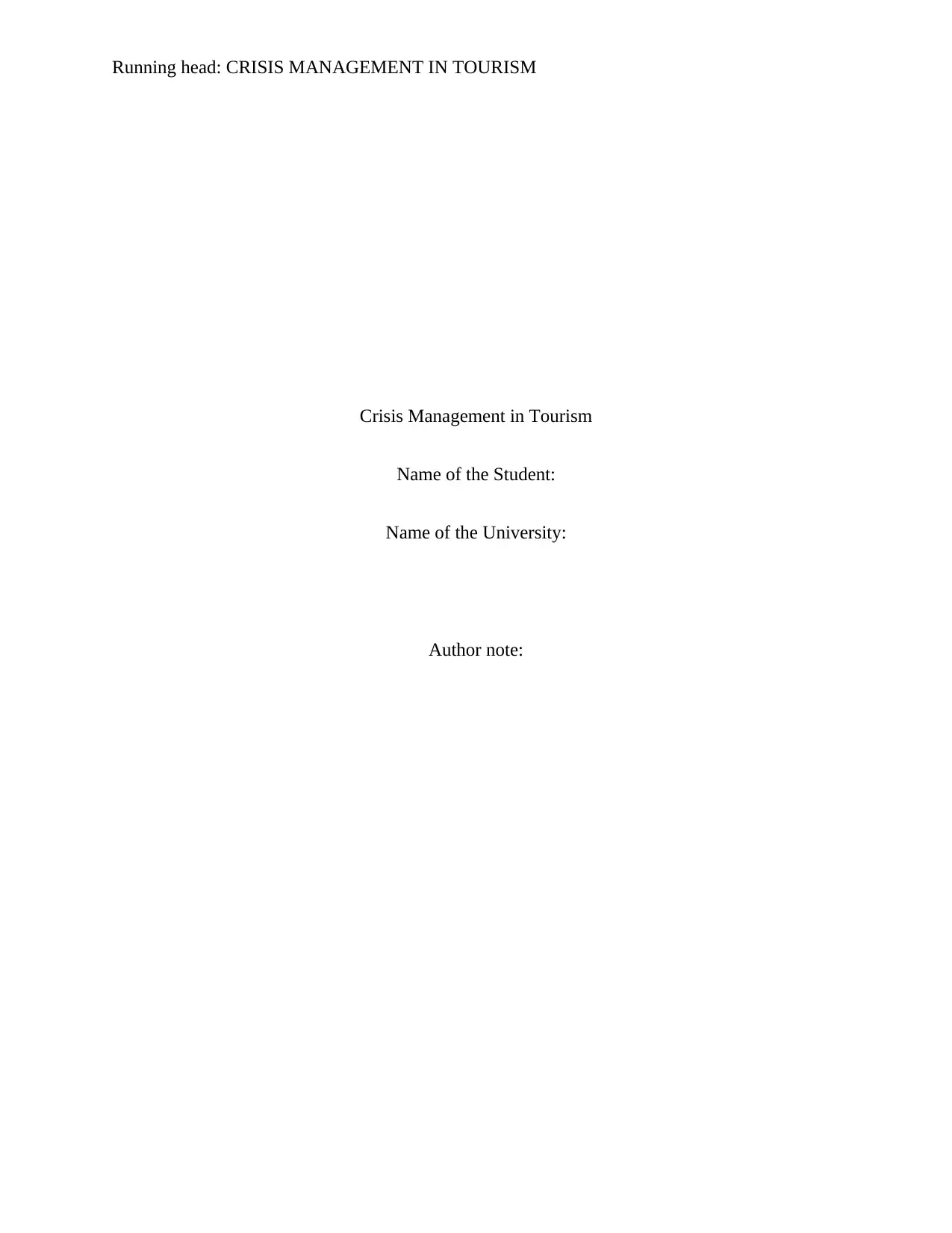
Running head: CRISIS MANAGEMENT IN TOURISM
Crisis Management in Tourism
Name of the Student:
Name of the University:
Author note:
Crisis Management in Tourism
Name of the Student:
Name of the University:
Author note:
Paraphrase This Document
Need a fresh take? Get an instant paraphrase of this document with our AI Paraphraser
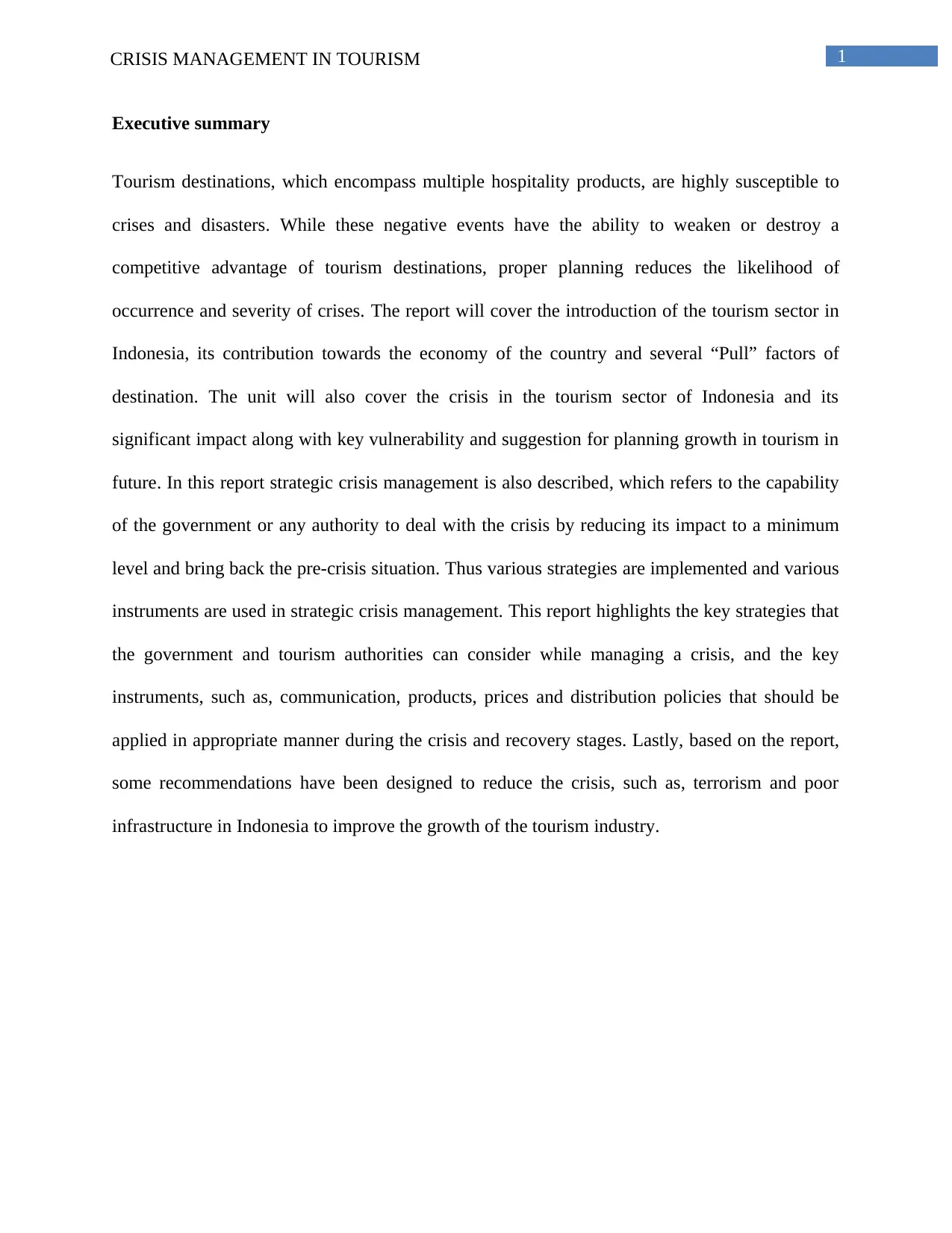
1CRISIS MANAGEMENT IN TOURISM
Executive summary
Tourism destinations, which encompass multiple hospitality products, are highly susceptible to
crises and disasters. While these negative events have the ability to weaken or destroy a
competitive advantage of tourism destinations, proper planning reduces the likelihood of
occurrence and severity of crises. The report will cover the introduction of the tourism sector in
Indonesia, its contribution towards the economy of the country and several “Pull” factors of
destination. The unit will also cover the crisis in the tourism sector of Indonesia and its
significant impact along with key vulnerability and suggestion for planning growth in tourism in
future. In this report strategic crisis management is also described, which refers to the capability
of the government or any authority to deal with the crisis by reducing its impact to a minimum
level and bring back the pre-crisis situation. Thus various strategies are implemented and various
instruments are used in strategic crisis management. This report highlights the key strategies that
the government and tourism authorities can consider while managing a crisis, and the key
instruments, such as, communication, products, prices and distribution policies that should be
applied in appropriate manner during the crisis and recovery stages. Lastly, based on the report,
some recommendations have been designed to reduce the crisis, such as, terrorism and poor
infrastructure in Indonesia to improve the growth of the tourism industry.
Executive summary
Tourism destinations, which encompass multiple hospitality products, are highly susceptible to
crises and disasters. While these negative events have the ability to weaken or destroy a
competitive advantage of tourism destinations, proper planning reduces the likelihood of
occurrence and severity of crises. The report will cover the introduction of the tourism sector in
Indonesia, its contribution towards the economy of the country and several “Pull” factors of
destination. The unit will also cover the crisis in the tourism sector of Indonesia and its
significant impact along with key vulnerability and suggestion for planning growth in tourism in
future. In this report strategic crisis management is also described, which refers to the capability
of the government or any authority to deal with the crisis by reducing its impact to a minimum
level and bring back the pre-crisis situation. Thus various strategies are implemented and various
instruments are used in strategic crisis management. This report highlights the key strategies that
the government and tourism authorities can consider while managing a crisis, and the key
instruments, such as, communication, products, prices and distribution policies that should be
applied in appropriate manner during the crisis and recovery stages. Lastly, based on the report,
some recommendations have been designed to reduce the crisis, such as, terrorism and poor
infrastructure in Indonesia to improve the growth of the tourism industry.
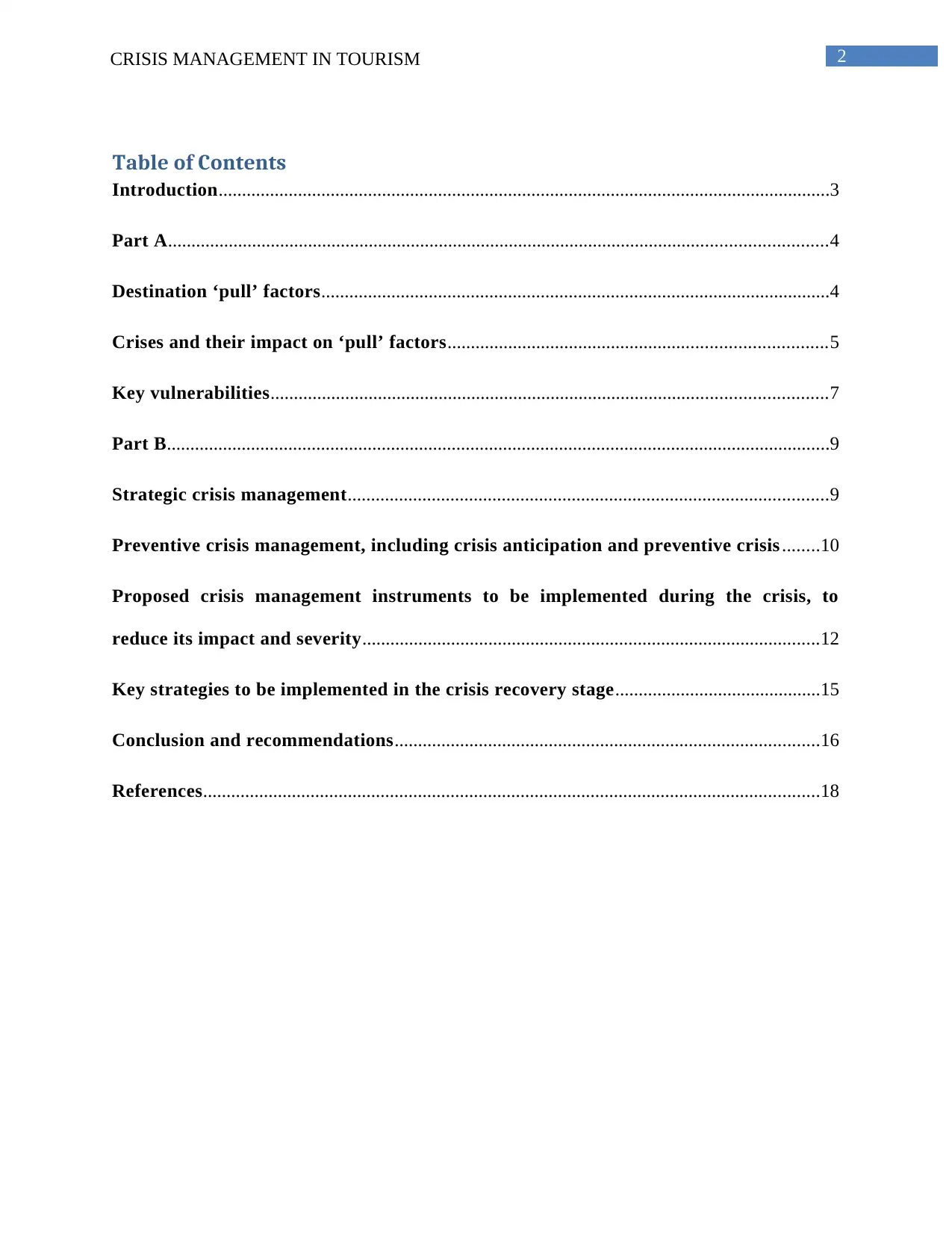
2CRISIS MANAGEMENT IN TOURISM
Table of Contents
Introduction...................................................................................................................................3
Part A.............................................................................................................................................4
Destination ‘pull’ factors.............................................................................................................4
Crises and their impact on ‘pull’ factors.................................................................................5
Key vulnerabilities.......................................................................................................................7
Part B..............................................................................................................................................9
Strategic crisis management.......................................................................................................9
Preventive crisis management, including crisis anticipation and preventive crisis ........10
Proposed crisis management instruments to be implemented during the crisis, to
reduce its impact and severity..................................................................................................12
Key strategies to be implemented in the crisis recovery stage............................................15
Conclusion and recommendations...........................................................................................16
References....................................................................................................................................18
Table of Contents
Introduction...................................................................................................................................3
Part A.............................................................................................................................................4
Destination ‘pull’ factors.............................................................................................................4
Crises and their impact on ‘pull’ factors.................................................................................5
Key vulnerabilities.......................................................................................................................7
Part B..............................................................................................................................................9
Strategic crisis management.......................................................................................................9
Preventive crisis management, including crisis anticipation and preventive crisis ........10
Proposed crisis management instruments to be implemented during the crisis, to
reduce its impact and severity..................................................................................................12
Key strategies to be implemented in the crisis recovery stage............................................15
Conclusion and recommendations...........................................................................................16
References....................................................................................................................................18
⊘ This is a preview!⊘
Do you want full access?
Subscribe today to unlock all pages.

Trusted by 1+ million students worldwide
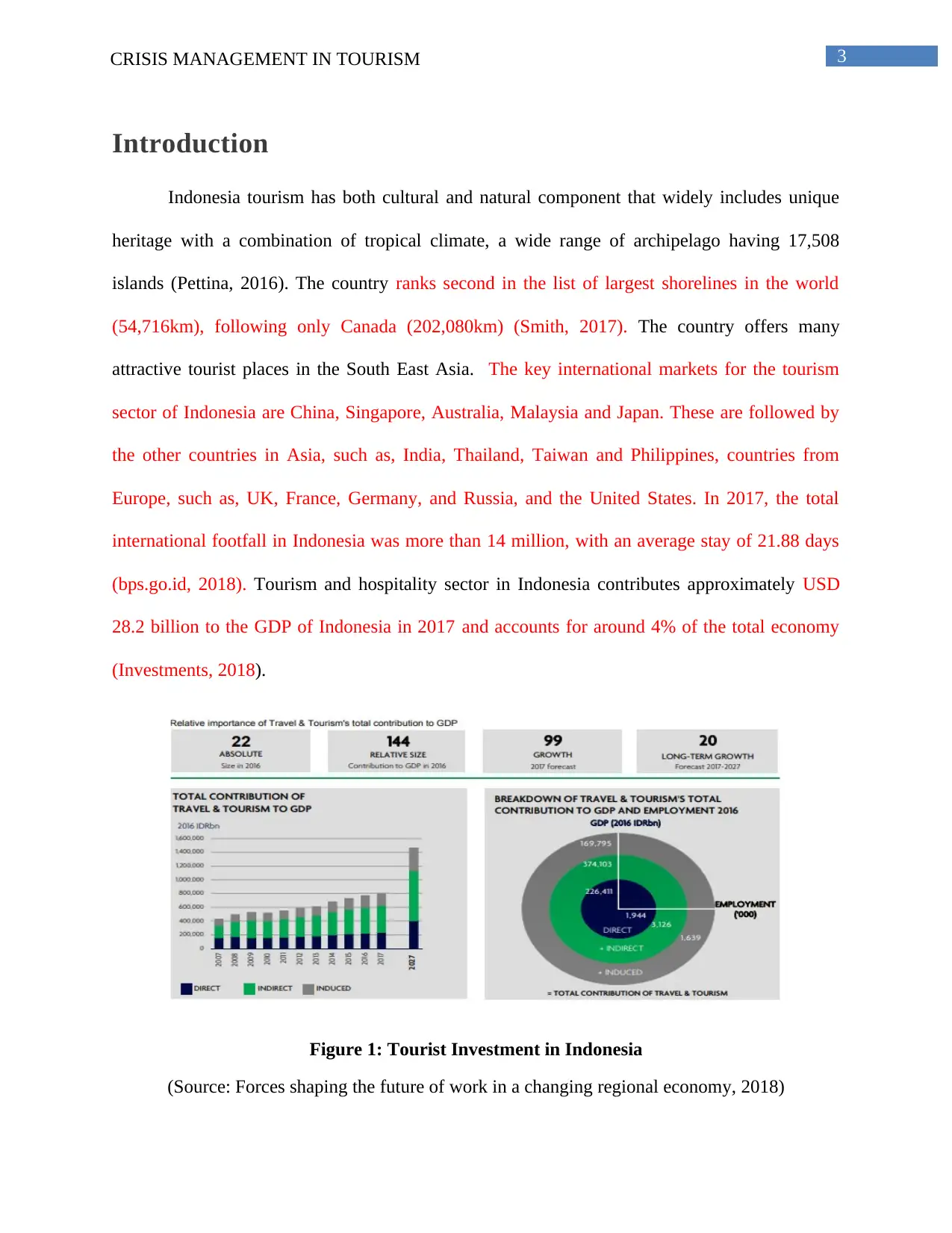
3CRISIS MANAGEMENT IN TOURISM
Introduction
Indonesia tourism has both cultural and natural component that widely includes unique
heritage with a combination of tropical climate, a wide range of archipelago having 17,508
islands (Pettina, 2016). The country ranks second in the list of largest shorelines in the world
(54,716km), following only Canada (202,080km) (Smith, 2017). The country offers many
attractive tourist places in the South East Asia. The key international markets for the tourism
sector of Indonesia are China, Singapore, Australia, Malaysia and Japan. These are followed by
the other countries in Asia, such as, India, Thailand, Taiwan and Philippines, countries from
Europe, such as, UK, France, Germany, and Russia, and the United States. In 2017, the total
international footfall in Indonesia was more than 14 million, with an average stay of 21.88 days
(bps.go.id, 2018). Tourism and hospitality sector in Indonesia contributes approximately USD
28.2 billion to the GDP of Indonesia in 2017 and accounts for around 4% of the total economy
(Investments, 2018).
Figure 1: Tourist Investment in Indonesia
(Source: Forces shaping the future of work in a changing regional economy, 2018)
Introduction
Indonesia tourism has both cultural and natural component that widely includes unique
heritage with a combination of tropical climate, a wide range of archipelago having 17,508
islands (Pettina, 2016). The country ranks second in the list of largest shorelines in the world
(54,716km), following only Canada (202,080km) (Smith, 2017). The country offers many
attractive tourist places in the South East Asia. The key international markets for the tourism
sector of Indonesia are China, Singapore, Australia, Malaysia and Japan. These are followed by
the other countries in Asia, such as, India, Thailand, Taiwan and Philippines, countries from
Europe, such as, UK, France, Germany, and Russia, and the United States. In 2017, the total
international footfall in Indonesia was more than 14 million, with an average stay of 21.88 days
(bps.go.id, 2018). Tourism and hospitality sector in Indonesia contributes approximately USD
28.2 billion to the GDP of Indonesia in 2017 and accounts for around 4% of the total economy
(Investments, 2018).
Figure 1: Tourist Investment in Indonesia
(Source: Forces shaping the future of work in a changing regional economy, 2018)
Paraphrase This Document
Need a fresh take? Get an instant paraphrase of this document with our AI Paraphraser
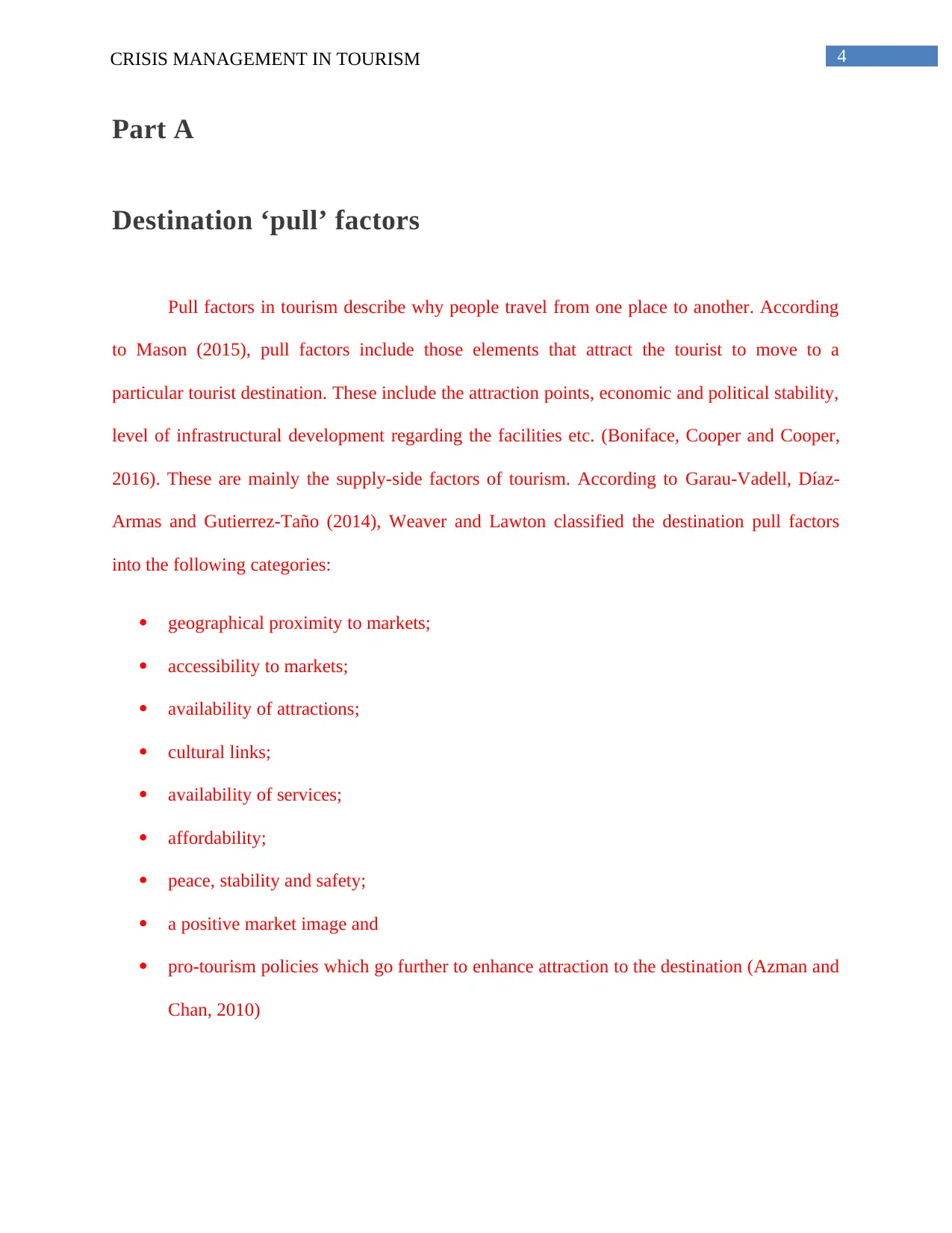
4CRISIS MANAGEMENT IN TOURISM
Part A
Destination ‘pull’ factors
Pull factors in tourism describe why people travel from one place to another. According
to Mason (2015), pull factors include those elements that attract the tourist to move to a
particular tourist destination. These include the attraction points, economic and political stability,
level of infrastructural development regarding the facilities etc. (Boniface, Cooper and Cooper,
2016). These are mainly the supply-side factors of tourism. According to Garau-Vadell, Díaz-
Armas and Gutierrez-Taño (2014), Weaver and Lawton classified the destination pull factors
into the following categories:
geographical proximity to markets;
accessibility to markets;
availability of attractions;
cultural links;
availability of services;
affordability;
peace, stability and safety;
a positive market image and
pro-tourism policies which go further to enhance attraction to the destination (Azman and
Chan, 2010)
Part A
Destination ‘pull’ factors
Pull factors in tourism describe why people travel from one place to another. According
to Mason (2015), pull factors include those elements that attract the tourist to move to a
particular tourist destination. These include the attraction points, economic and political stability,
level of infrastructural development regarding the facilities etc. (Boniface, Cooper and Cooper,
2016). These are mainly the supply-side factors of tourism. According to Garau-Vadell, Díaz-
Armas and Gutierrez-Taño (2014), Weaver and Lawton classified the destination pull factors
into the following categories:
geographical proximity to markets;
accessibility to markets;
availability of attractions;
cultural links;
availability of services;
affordability;
peace, stability and safety;
a positive market image and
pro-tourism policies which go further to enhance attraction to the destination (Azman and
Chan, 2010)
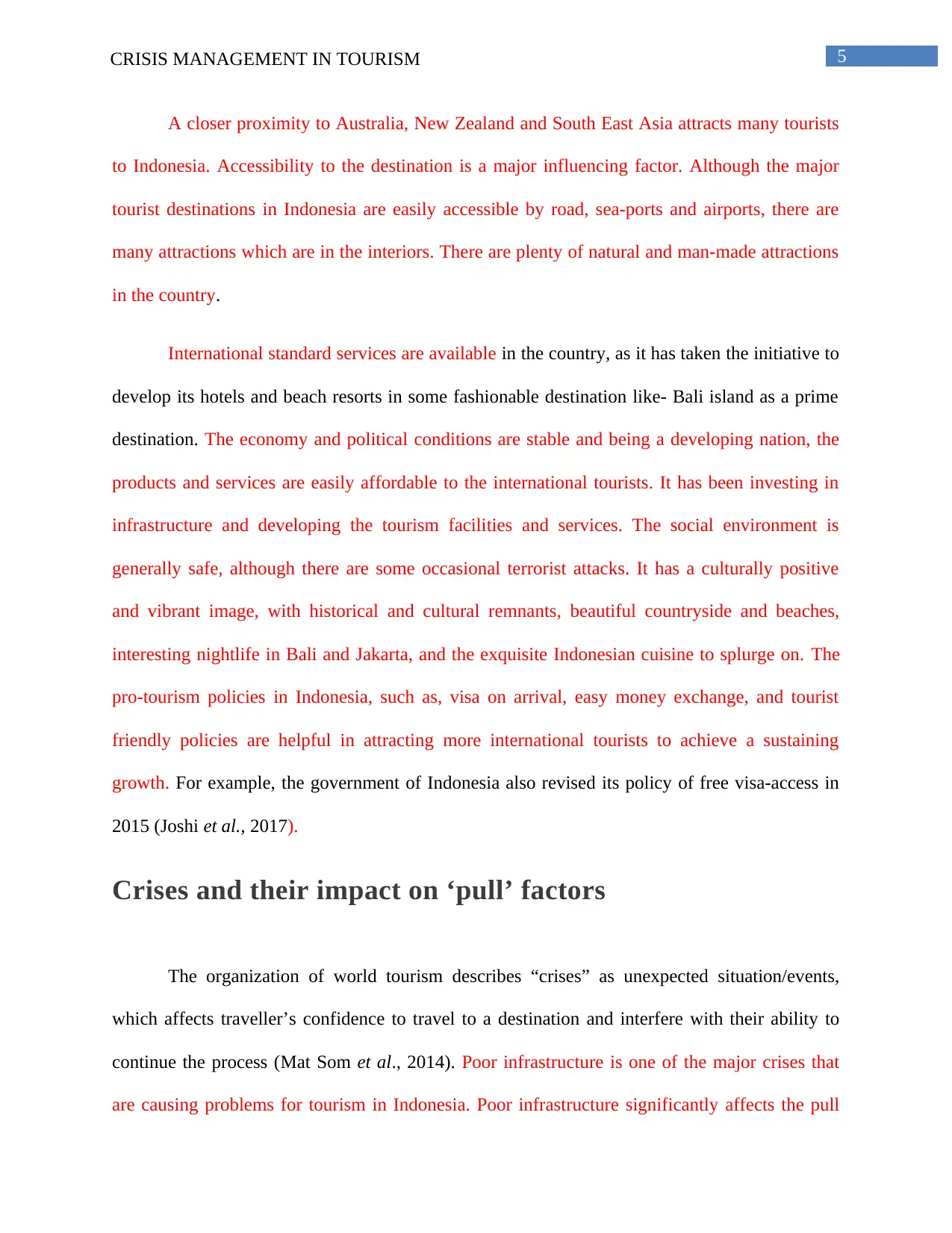
5CRISIS MANAGEMENT IN TOURISM
A closer proximity to Australia, New Zealand and South East Asia attracts many tourists
to Indonesia. Accessibility to the destination is a major influencing factor. Although the major
tourist destinations in Indonesia are easily accessible by road, sea-ports and airports, there are
many attractions which are in the interiors. There are plenty of natural and man-made attractions
in the country.
International standard services are available in the country, as it has taken the initiative to
develop its hotels and beach resorts in some fashionable destination like- Bali island as a prime
destination. The economy and political conditions are stable and being a developing nation, the
products and services are easily affordable to the international tourists. It has been investing in
infrastructure and developing the tourism facilities and services. The social environment is
generally safe, although there are some occasional terrorist attacks. It has a culturally positive
and vibrant image, with historical and cultural remnants, beautiful countryside and beaches,
interesting nightlife in Bali and Jakarta, and the exquisite Indonesian cuisine to splurge on. The
pro-tourism policies in Indonesia, such as, visa on arrival, easy money exchange, and tourist
friendly policies are helpful in attracting more international tourists to achieve a sustaining
growth. For example, the government of Indonesia also revised its policy of free visa-access in
2015 (Joshi et al., 2017).
Crises and their impact on ‘pull’ factors
The organization of world tourism describes “crises” as unexpected situation/events,
which affects traveller’s confidence to travel to a destination and interfere with their ability to
continue the process (Mat Som et al., 2014). Poor infrastructure is one of the major crises that
are causing problems for tourism in Indonesia. Poor infrastructure significantly affects the pull
A closer proximity to Australia, New Zealand and South East Asia attracts many tourists
to Indonesia. Accessibility to the destination is a major influencing factor. Although the major
tourist destinations in Indonesia are easily accessible by road, sea-ports and airports, there are
many attractions which are in the interiors. There are plenty of natural and man-made attractions
in the country.
International standard services are available in the country, as it has taken the initiative to
develop its hotels and beach resorts in some fashionable destination like- Bali island as a prime
destination. The economy and political conditions are stable and being a developing nation, the
products and services are easily affordable to the international tourists. It has been investing in
infrastructure and developing the tourism facilities and services. The social environment is
generally safe, although there are some occasional terrorist attacks. It has a culturally positive
and vibrant image, with historical and cultural remnants, beautiful countryside and beaches,
interesting nightlife in Bali and Jakarta, and the exquisite Indonesian cuisine to splurge on. The
pro-tourism policies in Indonesia, such as, visa on arrival, easy money exchange, and tourist
friendly policies are helpful in attracting more international tourists to achieve a sustaining
growth. For example, the government of Indonesia also revised its policy of free visa-access in
2015 (Joshi et al., 2017).
Crises and their impact on ‘pull’ factors
The organization of world tourism describes “crises” as unexpected situation/events,
which affects traveller’s confidence to travel to a destination and interfere with their ability to
continue the process (Mat Som et al., 2014). Poor infrastructure is one of the major crises that
are causing problems for tourism in Indonesia. Poor infrastructure significantly affects the pull
⊘ This is a preview!⊘
Do you want full access?
Subscribe today to unlock all pages.

Trusted by 1+ million students worldwide
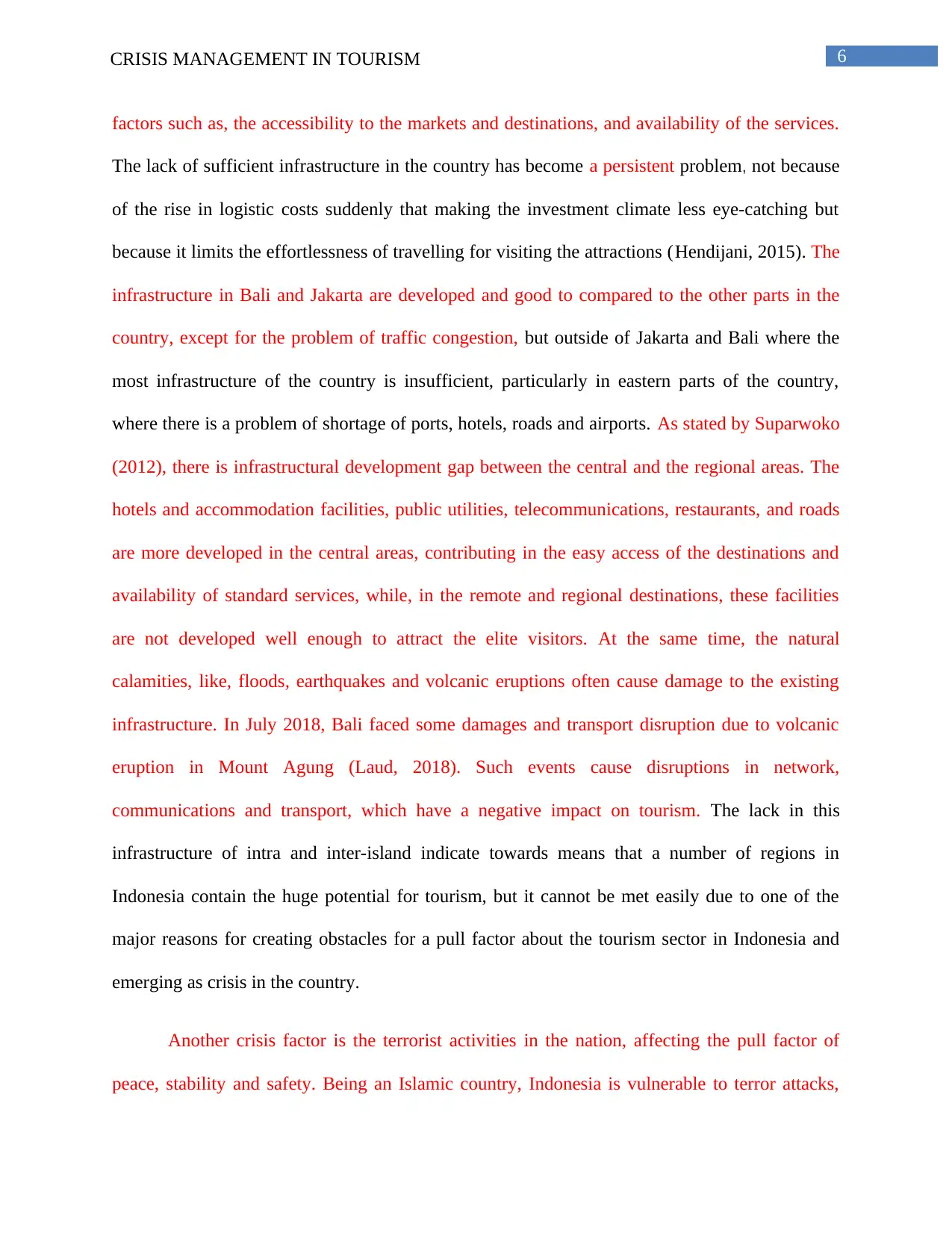
6CRISIS MANAGEMENT IN TOURISM
factors such as, the accessibility to the markets and destinations, and availability of the services.
The lack of sufficient infrastructure in the country has become a persistent problem, not because
of the rise in logistic costs suddenly that making the investment climate less eye-catching but
because it limits the effortlessness of travelling for visiting the attractions (Hendijani, 2015). The
infrastructure in Bali and Jakarta are developed and good to compared to the other parts in the
country, except for the problem of traffic congestion, but outside of Jakarta and Bali where the
most infrastructure of the country is insufficient, particularly in eastern parts of the country,
where there is a problem of shortage of ports, hotels, roads and airports. As stated by Suparwoko
(2012), there is infrastructural development gap between the central and the regional areas. The
hotels and accommodation facilities, public utilities, telecommunications, restaurants, and roads
are more developed in the central areas, contributing in the easy access of the destinations and
availability of standard services, while, in the remote and regional destinations, these facilities
are not developed well enough to attract the elite visitors. At the same time, the natural
calamities, like, floods, earthquakes and volcanic eruptions often cause damage to the existing
infrastructure. In July 2018, Bali faced some damages and transport disruption due to volcanic
eruption in Mount Agung (Laud, 2018). Such events cause disruptions in network,
communications and transport, which have a negative impact on tourism. The lack in this
infrastructure of intra and inter-island indicate towards means that a number of regions in
Indonesia contain the huge potential for tourism, but it cannot be met easily due to one of the
major reasons for creating obstacles for a pull factor about the tourism sector in Indonesia and
emerging as crisis in the country.
Another crisis factor is the terrorist activities in the nation, affecting the pull factor of
peace, stability and safety. Being an Islamic country, Indonesia is vulnerable to terror attacks,
factors such as, the accessibility to the markets and destinations, and availability of the services.
The lack of sufficient infrastructure in the country has become a persistent problem, not because
of the rise in logistic costs suddenly that making the investment climate less eye-catching but
because it limits the effortlessness of travelling for visiting the attractions (Hendijani, 2015). The
infrastructure in Bali and Jakarta are developed and good to compared to the other parts in the
country, except for the problem of traffic congestion, but outside of Jakarta and Bali where the
most infrastructure of the country is insufficient, particularly in eastern parts of the country,
where there is a problem of shortage of ports, hotels, roads and airports. As stated by Suparwoko
(2012), there is infrastructural development gap between the central and the regional areas. The
hotels and accommodation facilities, public utilities, telecommunications, restaurants, and roads
are more developed in the central areas, contributing in the easy access of the destinations and
availability of standard services, while, in the remote and regional destinations, these facilities
are not developed well enough to attract the elite visitors. At the same time, the natural
calamities, like, floods, earthquakes and volcanic eruptions often cause damage to the existing
infrastructure. In July 2018, Bali faced some damages and transport disruption due to volcanic
eruption in Mount Agung (Laud, 2018). Such events cause disruptions in network,
communications and transport, which have a negative impact on tourism. The lack in this
infrastructure of intra and inter-island indicate towards means that a number of regions in
Indonesia contain the huge potential for tourism, but it cannot be met easily due to one of the
major reasons for creating obstacles for a pull factor about the tourism sector in Indonesia and
emerging as crisis in the country.
Another crisis factor is the terrorist activities in the nation, affecting the pull factor of
peace, stability and safety. Being an Islamic country, Indonesia is vulnerable to terror attacks,
Paraphrase This Document
Need a fresh take? Get an instant paraphrase of this document with our AI Paraphraser
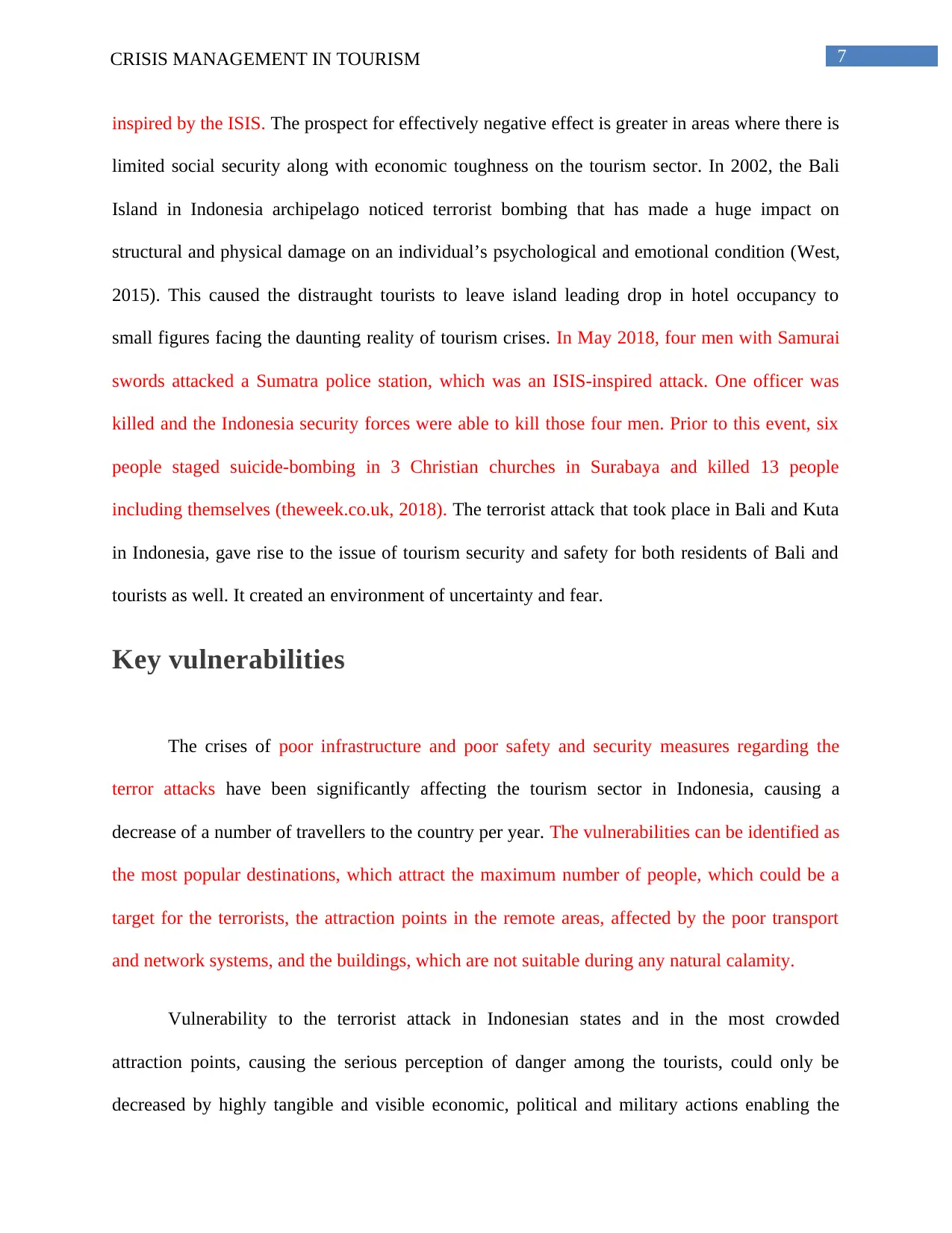
7CRISIS MANAGEMENT IN TOURISM
inspired by the ISIS. The prospect for effectively negative effect is greater in areas where there is
limited social security along with economic toughness on the tourism sector. In 2002, the Bali
Island in Indonesia archipelago noticed terrorist bombing that has made a huge impact on
structural and physical damage on an individual’s psychological and emotional condition (West,
2015). This caused the distraught tourists to leave island leading drop in hotel occupancy to
small figures facing the daunting reality of tourism crises. In May 2018, four men with Samurai
swords attacked a Sumatra police station, which was an ISIS-inspired attack. One officer was
killed and the Indonesia security forces were able to kill those four men. Prior to this event, six
people staged suicide-bombing in 3 Christian churches in Surabaya and killed 13 people
including themselves (theweek.co.uk, 2018). The terrorist attack that took place in Bali and Kuta
in Indonesia, gave rise to the issue of tourism security and safety for both residents of Bali and
tourists as well. It created an environment of uncertainty and fear.
Key vulnerabilities
The crises of poor infrastructure and poor safety and security measures regarding the
terror attacks have been significantly affecting the tourism sector in Indonesia, causing a
decrease of a number of travellers to the country per year. The vulnerabilities can be identified as
the most popular destinations, which attract the maximum number of people, which could be a
target for the terrorists, the attraction points in the remote areas, affected by the poor transport
and network systems, and the buildings, which are not suitable during any natural calamity.
Vulnerability to the terrorist attack in Indonesian states and in the most crowded
attraction points, causing the serious perception of danger among the tourists, could only be
decreased by highly tangible and visible economic, political and military actions enabling the
inspired by the ISIS. The prospect for effectively negative effect is greater in areas where there is
limited social security along with economic toughness on the tourism sector. In 2002, the Bali
Island in Indonesia archipelago noticed terrorist bombing that has made a huge impact on
structural and physical damage on an individual’s psychological and emotional condition (West,
2015). This caused the distraught tourists to leave island leading drop in hotel occupancy to
small figures facing the daunting reality of tourism crises. In May 2018, four men with Samurai
swords attacked a Sumatra police station, which was an ISIS-inspired attack. One officer was
killed and the Indonesia security forces were able to kill those four men. Prior to this event, six
people staged suicide-bombing in 3 Christian churches in Surabaya and killed 13 people
including themselves (theweek.co.uk, 2018). The terrorist attack that took place in Bali and Kuta
in Indonesia, gave rise to the issue of tourism security and safety for both residents of Bali and
tourists as well. It created an environment of uncertainty and fear.
Key vulnerabilities
The crises of poor infrastructure and poor safety and security measures regarding the
terror attacks have been significantly affecting the tourism sector in Indonesia, causing a
decrease of a number of travellers to the country per year. The vulnerabilities can be identified as
the most popular destinations, which attract the maximum number of people, which could be a
target for the terrorists, the attraction points in the remote areas, affected by the poor transport
and network systems, and the buildings, which are not suitable during any natural calamity.
Vulnerability to the terrorist attack in Indonesian states and in the most crowded
attraction points, causing the serious perception of danger among the tourists, could only be
decreased by highly tangible and visible economic, political and military actions enabling the
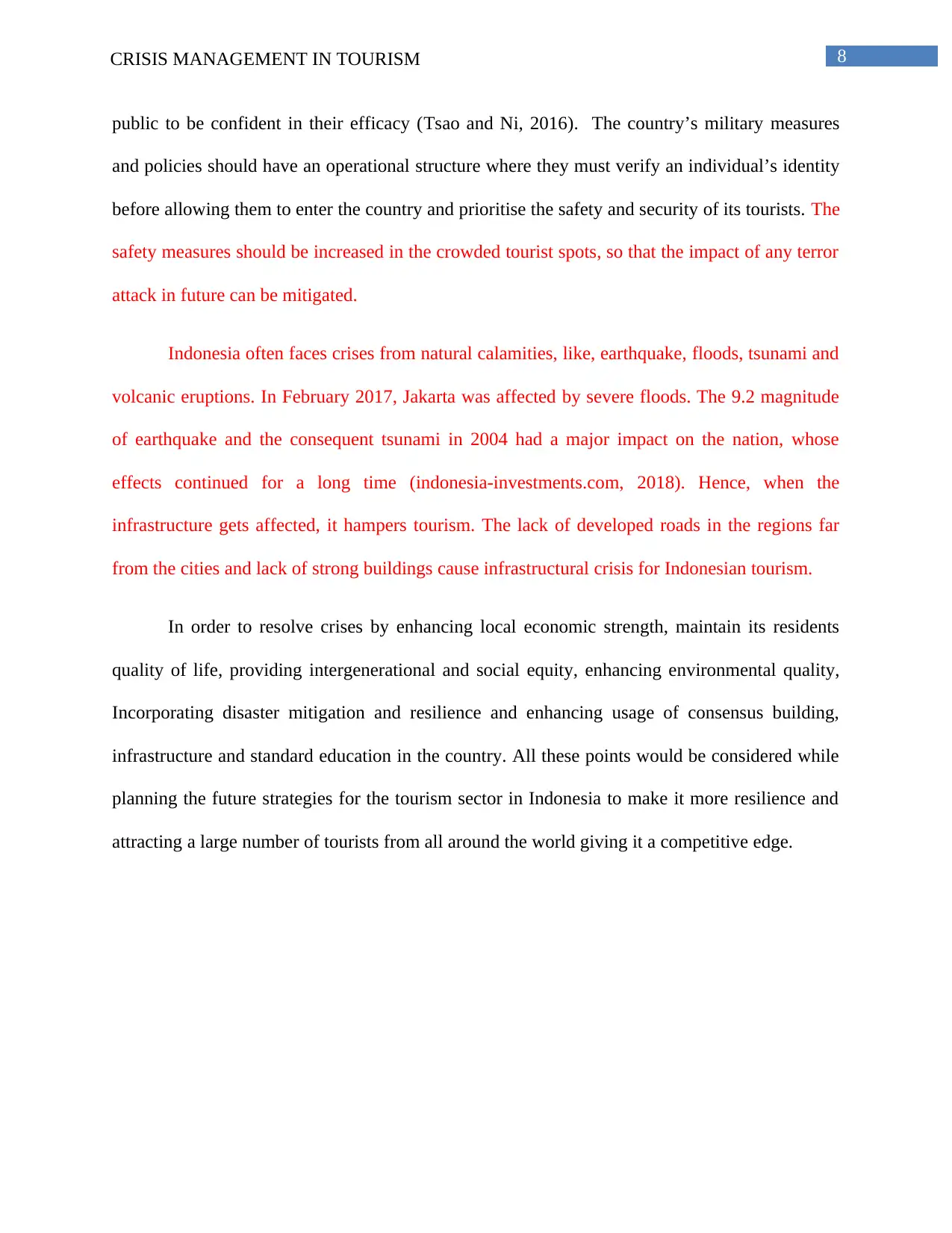
8CRISIS MANAGEMENT IN TOURISM
public to be confident in their efficacy (Tsao and Ni, 2016). The country’s military measures
and policies should have an operational structure where they must verify an individual’s identity
before allowing them to enter the country and prioritise the safety and security of its tourists. The
safety measures should be increased in the crowded tourist spots, so that the impact of any terror
attack in future can be mitigated.
Indonesia often faces crises from natural calamities, like, earthquake, floods, tsunami and
volcanic eruptions. In February 2017, Jakarta was affected by severe floods. The 9.2 magnitude
of earthquake and the consequent tsunami in 2004 had a major impact on the nation, whose
effects continued for a long time (indonesia-investments.com, 2018). Hence, when the
infrastructure gets affected, it hampers tourism. The lack of developed roads in the regions far
from the cities and lack of strong buildings cause infrastructural crisis for Indonesian tourism.
In order to resolve crises by enhancing local economic strength, maintain its residents
quality of life, providing intergenerational and social equity, enhancing environmental quality,
Incorporating disaster mitigation and resilience and enhancing usage of consensus building,
infrastructure and standard education in the country. All these points would be considered while
planning the future strategies for the tourism sector in Indonesia to make it more resilience and
attracting a large number of tourists from all around the world giving it a competitive edge.
public to be confident in their efficacy (Tsao and Ni, 2016). The country’s military measures
and policies should have an operational structure where they must verify an individual’s identity
before allowing them to enter the country and prioritise the safety and security of its tourists. The
safety measures should be increased in the crowded tourist spots, so that the impact of any terror
attack in future can be mitigated.
Indonesia often faces crises from natural calamities, like, earthquake, floods, tsunami and
volcanic eruptions. In February 2017, Jakarta was affected by severe floods. The 9.2 magnitude
of earthquake and the consequent tsunami in 2004 had a major impact on the nation, whose
effects continued for a long time (indonesia-investments.com, 2018). Hence, when the
infrastructure gets affected, it hampers tourism. The lack of developed roads in the regions far
from the cities and lack of strong buildings cause infrastructural crisis for Indonesian tourism.
In order to resolve crises by enhancing local economic strength, maintain its residents
quality of life, providing intergenerational and social equity, enhancing environmental quality,
Incorporating disaster mitigation and resilience and enhancing usage of consensus building,
infrastructure and standard education in the country. All these points would be considered while
planning the future strategies for the tourism sector in Indonesia to make it more resilience and
attracting a large number of tourists from all around the world giving it a competitive edge.
⊘ This is a preview!⊘
Do you want full access?
Subscribe today to unlock all pages.

Trusted by 1+ million students worldwide
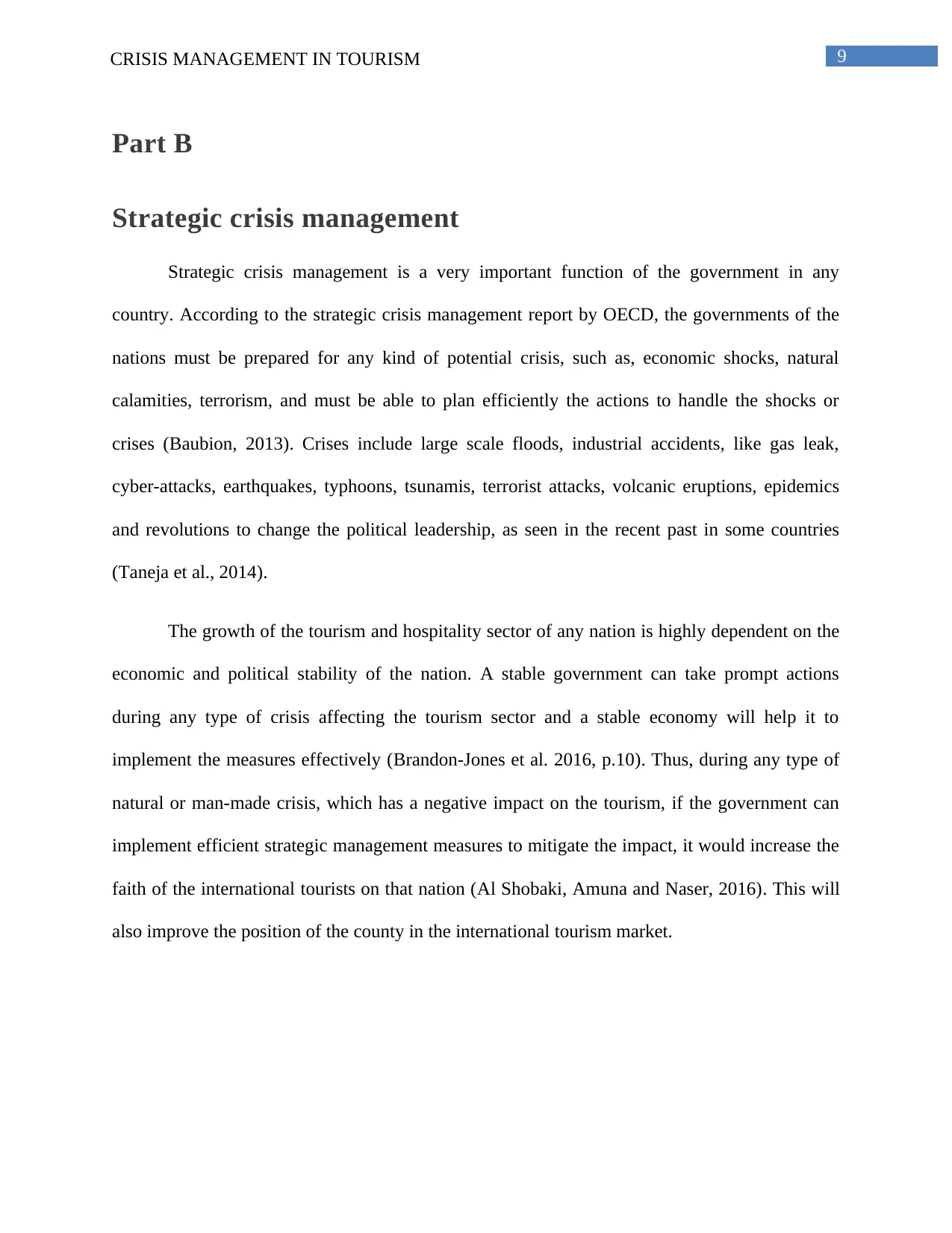
9CRISIS MANAGEMENT IN TOURISM
Part B
Strategic crisis management
Strategic crisis management is a very important function of the government in any
country. According to the strategic crisis management report by OECD, the governments of the
nations must be prepared for any kind of potential crisis, such as, economic shocks, natural
calamities, terrorism, and must be able to plan efficiently the actions to handle the shocks or
crises (Baubion, 2013). Crises include large scale floods, industrial accidents, like gas leak,
cyber-attacks, earthquakes, typhoons, tsunamis, terrorist attacks, volcanic eruptions, epidemics
and revolutions to change the political leadership, as seen in the recent past in some countries
(Taneja et al., 2014).
The growth of the tourism and hospitality sector of any nation is highly dependent on the
economic and political stability of the nation. A stable government can take prompt actions
during any type of crisis affecting the tourism sector and a stable economy will help it to
implement the measures effectively (Brandon-Jones et al. 2016, p.10). Thus, during any type of
natural or man-made crisis, which has a negative impact on the tourism, if the government can
implement efficient strategic management measures to mitigate the impact, it would increase the
faith of the international tourists on that nation (Al Shobaki, Amuna and Naser, 2016). This will
also improve the position of the county in the international tourism market.
Part B
Strategic crisis management
Strategic crisis management is a very important function of the government in any
country. According to the strategic crisis management report by OECD, the governments of the
nations must be prepared for any kind of potential crisis, such as, economic shocks, natural
calamities, terrorism, and must be able to plan efficiently the actions to handle the shocks or
crises (Baubion, 2013). Crises include large scale floods, industrial accidents, like gas leak,
cyber-attacks, earthquakes, typhoons, tsunamis, terrorist attacks, volcanic eruptions, epidemics
and revolutions to change the political leadership, as seen in the recent past in some countries
(Taneja et al., 2014).
The growth of the tourism and hospitality sector of any nation is highly dependent on the
economic and political stability of the nation. A stable government can take prompt actions
during any type of crisis affecting the tourism sector and a stable economy will help it to
implement the measures effectively (Brandon-Jones et al. 2016, p.10). Thus, during any type of
natural or man-made crisis, which has a negative impact on the tourism, if the government can
implement efficient strategic management measures to mitigate the impact, it would increase the
faith of the international tourists on that nation (Al Shobaki, Amuna and Naser, 2016). This will
also improve the position of the county in the international tourism market.
Paraphrase This Document
Need a fresh take? Get an instant paraphrase of this document with our AI Paraphraser
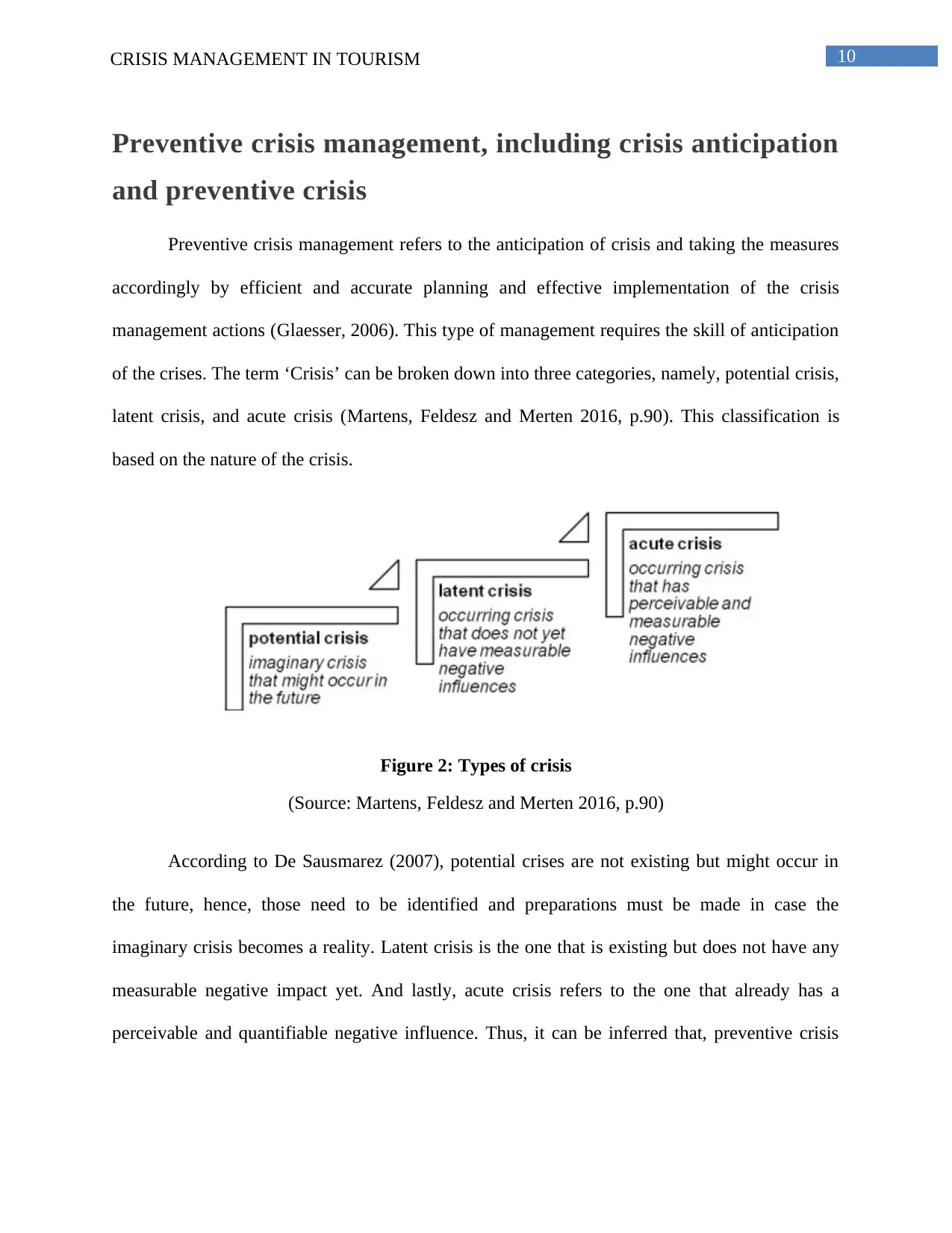
10CRISIS MANAGEMENT IN TOURISM
Preventive crisis management, including crisis anticipation
and preventive crisis
Preventive crisis management refers to the anticipation of crisis and taking the measures
accordingly by efficient and accurate planning and effective implementation of the crisis
management actions (Glaesser, 2006). This type of management requires the skill of anticipation
of the crises. The term ‘Crisis’ can be broken down into three categories, namely, potential crisis,
latent crisis, and acute crisis (Martens, Feldesz and Merten 2016, p.90). This classification is
based on the nature of the crisis.
Figure 2: Types of crisis
(Source: Martens, Feldesz and Merten 2016, p.90)
According to De Sausmarez (2007), potential crises are not existing but might occur in
the future, hence, those need to be identified and preparations must be made in case the
imaginary crisis becomes a reality. Latent crisis is the one that is existing but does not have any
measurable negative impact yet. And lastly, acute crisis refers to the one that already has a
perceivable and quantifiable negative influence. Thus, it can be inferred that, preventive crisis
Preventive crisis management, including crisis anticipation
and preventive crisis
Preventive crisis management refers to the anticipation of crisis and taking the measures
accordingly by efficient and accurate planning and effective implementation of the crisis
management actions (Glaesser, 2006). This type of management requires the skill of anticipation
of the crises. The term ‘Crisis’ can be broken down into three categories, namely, potential crisis,
latent crisis, and acute crisis (Martens, Feldesz and Merten 2016, p.90). This classification is
based on the nature of the crisis.
Figure 2: Types of crisis
(Source: Martens, Feldesz and Merten 2016, p.90)
According to De Sausmarez (2007), potential crises are not existing but might occur in
the future, hence, those need to be identified and preparations must be made in case the
imaginary crisis becomes a reality. Latent crisis is the one that is existing but does not have any
measurable negative impact yet. And lastly, acute crisis refers to the one that already has a
perceivable and quantifiable negative influence. Thus, it can be inferred that, preventive crisis
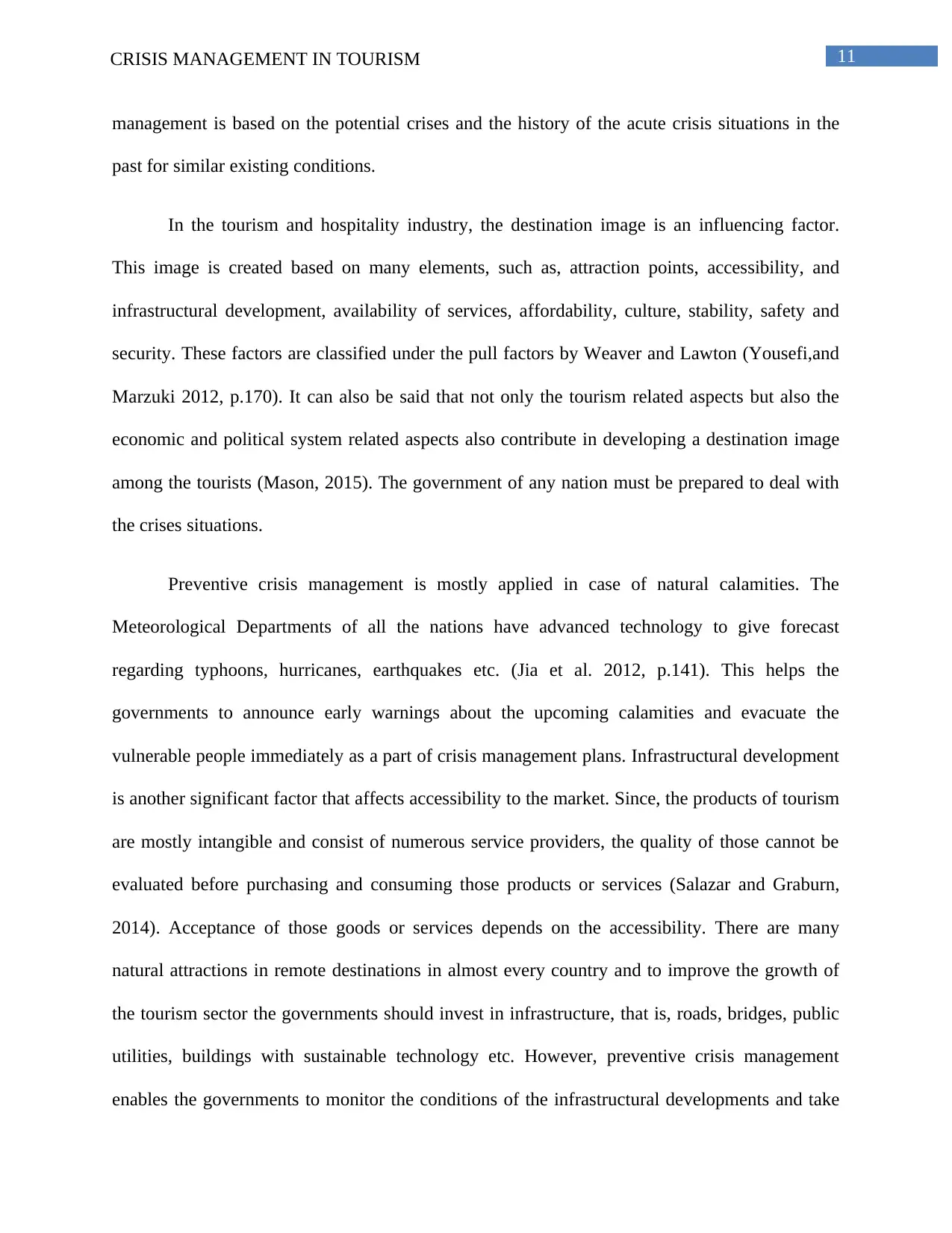
11CRISIS MANAGEMENT IN TOURISM
management is based on the potential crises and the history of the acute crisis situations in the
past for similar existing conditions.
In the tourism and hospitality industry, the destination image is an influencing factor.
This image is created based on many elements, such as, attraction points, accessibility, and
infrastructural development, availability of services, affordability, culture, stability, safety and
security. These factors are classified under the pull factors by Weaver and Lawton (Yousefi,and
Marzuki 2012, p.170). It can also be said that not only the tourism related aspects but also the
economic and political system related aspects also contribute in developing a destination image
among the tourists (Mason, 2015). The government of any nation must be prepared to deal with
the crises situations.
Preventive crisis management is mostly applied in case of natural calamities. The
Meteorological Departments of all the nations have advanced technology to give forecast
regarding typhoons, hurricanes, earthquakes etc. (Jia et al. 2012, p.141). This helps the
governments to announce early warnings about the upcoming calamities and evacuate the
vulnerable people immediately as a part of crisis management plans. Infrastructural development
is another significant factor that affects accessibility to the market. Since, the products of tourism
are mostly intangible and consist of numerous service providers, the quality of those cannot be
evaluated before purchasing and consuming those products or services (Salazar and Graburn,
2014). Acceptance of those goods or services depends on the accessibility. There are many
natural attractions in remote destinations in almost every country and to improve the growth of
the tourism sector the governments should invest in infrastructure, that is, roads, bridges, public
utilities, buildings with sustainable technology etc. However, preventive crisis management
enables the governments to monitor the conditions of the infrastructural developments and take
management is based on the potential crises and the history of the acute crisis situations in the
past for similar existing conditions.
In the tourism and hospitality industry, the destination image is an influencing factor.
This image is created based on many elements, such as, attraction points, accessibility, and
infrastructural development, availability of services, affordability, culture, stability, safety and
security. These factors are classified under the pull factors by Weaver and Lawton (Yousefi,and
Marzuki 2012, p.170). It can also be said that not only the tourism related aspects but also the
economic and political system related aspects also contribute in developing a destination image
among the tourists (Mason, 2015). The government of any nation must be prepared to deal with
the crises situations.
Preventive crisis management is mostly applied in case of natural calamities. The
Meteorological Departments of all the nations have advanced technology to give forecast
regarding typhoons, hurricanes, earthquakes etc. (Jia et al. 2012, p.141). This helps the
governments to announce early warnings about the upcoming calamities and evacuate the
vulnerable people immediately as a part of crisis management plans. Infrastructural development
is another significant factor that affects accessibility to the market. Since, the products of tourism
are mostly intangible and consist of numerous service providers, the quality of those cannot be
evaluated before purchasing and consuming those products or services (Salazar and Graburn,
2014). Acceptance of those goods or services depends on the accessibility. There are many
natural attractions in remote destinations in almost every country and to improve the growth of
the tourism sector the governments should invest in infrastructure, that is, roads, bridges, public
utilities, buildings with sustainable technology etc. However, preventive crisis management
enables the governments to monitor the conditions of the infrastructural developments and take
⊘ This is a preview!⊘
Do you want full access?
Subscribe today to unlock all pages.

Trusted by 1+ million students worldwide
1 out of 24
Related Documents
Your All-in-One AI-Powered Toolkit for Academic Success.
+13062052269
info@desklib.com
Available 24*7 on WhatsApp / Email
![[object Object]](/_next/static/media/star-bottom.7253800d.svg)
Unlock your academic potential
Copyright © 2020–2025 A2Z Services. All Rights Reserved. Developed and managed by ZUCOL.




